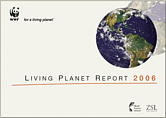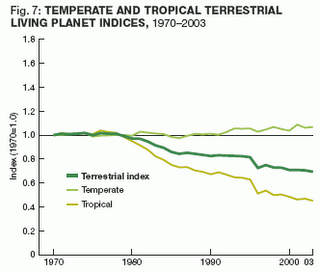Living Planet Index 2006
 Previously, I called for a species census to measure the population of all species so we can see man's impact on the globe. Rather than just worrying about species that are going extinct, we could see if previously large populations of animals were dwindling and stabilize their populations before they get close to extinction.
Previously, I called for a species census to measure the population of all species so we can see man's impact on the globe. Rather than just worrying about species that are going extinct, we could see if previously large populations of animals were dwindling and stabilize their populations before they get close to extinction.
Fat Knowledge threw down the gauntlet and the WWF responded. They just released the Living Planet Report for 2006. In it is the Living Planet Index which is determined as follows:The Living Planet Index measures trends in the Earth’s biological diversity. It tracks populations of 1 313 vertebrate species – fish, amphibians, reptiles, birds, mammals – from all around the world. Separate indices are produced for terrestrial, marine, and freshwater species, and the three trends are then averaged to create an aggregated index. Although vertebrates represent only a fraction of known species, it is assumed that trends in their populations are typical of biodiversity overall. By tracking wild species, the Living Planet Index is also monitoring the health of ecosystems.
That sounds pretty good and is the kind of report I was looking for. Of course I wonder how representative of all species it is as there are approximately 1.8 million known species, and another 13 million or more that have yet to be discovered.
The Living Planet Index is a measure of the state of the world’s biodiversity based on trends from 1970 to 2003 in over 3 600 populations of more than 1 300 vertebrate species from around the world.No attempt is made to select species on the basis of geography, ecology, or taxonomy, so the index dataset contains more population trends from well researched groups, especially birds, and well-studied regions, particularly Europe and North America.
Sounds like it might not be completely representative.
Another issue is that they appear to exclude all domesticated animals such as cattle, goats, pigs and chickens. I can understand that if you were calculating a Wildlife Planet Index, but this is the Living Planet Index. If you are trying to calculate the total amount of life on the planet (see my Pro Life Agenda and Net Primary Productivity) I don't see why you wouldn't count them as well.
Also because they track the same species year after year from 1970, it doesn't count "invasive" species and actually counts them as a negative when they replace native species. I prefer to call them "immigrant" species (of which the greatest immigrant species is a primate that originated in eastern Africa and has now spread across the globe) and they also should be counted in the total amount of life on the planet.
Alright, there are some potential issues, but what conclusions did they draw?Between 1970 and 2003, the index fell by about 30 percent.
That doesn't sound very good. What happens when you break it down by region?
Tropical species populations declined by around 55 per cent on average from 1970 to 2003, while temperate species populations, which would have shown marked declines prior to 1970, have shown little overall change since.
All of the species loss has occurred in the tropical region. The temperate species population has stabilized (which is not surprising since forests are increasing in most of the temperate countries).
A similar situation can be seen in the oceans as the population of species in the Pacific Ocean are stable and the Atlantic/Arctic region has shown a slight increase. Meanwhile populations are down 30% in the Southern Ocean and more than 50% in the Indian/Southeast Asian Ocean.
From these results, attention on species population needs to be focused on South America, Africa and Asia (although demand for timber and cattle from Europe, America and China might be part of the underlying problem).
In the future, I would like to see more species be censused (with a priority on the tropical species), including domesticated and immigrant species. This would truly make it a Living Planet Index and would still allow for people to look at the impact of just wild species if they choose. In would allow us to understand if in the tropical regions they are replacing wild species populations with domesticated ones, or is life just being lost.
While this report is a good step, I have other unanswered questions that hopefully will be addressed in future versions:
What would it take to stabilize species populations?
What is the impact of human population growth on these species populations?
What is the impact of one additional person living in a tropical or temperate region?
If an additional person has a smaller impact in temperate than tropical region would greater immigration from tropical regions to America and Europe lead to lower worldwide species population loss?
What is the impact of additional natural resource use by people?
Which natural resource use reduction would lead to the greatest increase in wildlife?
Can you quantify the trade off between additional human population, greater natural resource use and wild species populations?





No comments:
Post a Comment
Note: Only a member of this blog may post a comment.